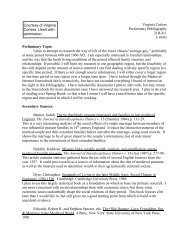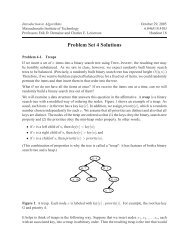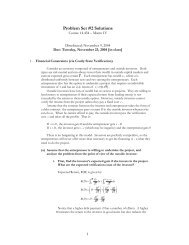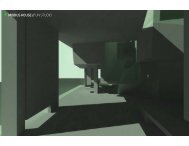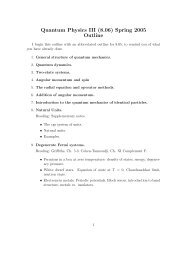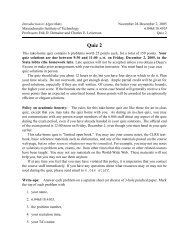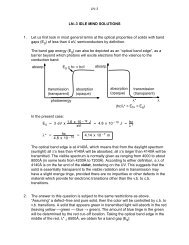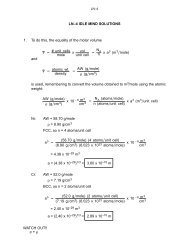DIFFUSION
DIFFUSION
DIFFUSION
You also want an ePaper? Increase the reach of your titles
YUMPU automatically turns print PDFs into web optimized ePapers that Google loves.
LN–9EXERCISE FOR THE IDLE MIND1. Aluminum is to be diffused into a silicon single crystal. At what temperature will thediffusion constant (D) be 5 x 10 –11 cm 2 /s? (Given: E A = 315 kJ/mole and D o =1.70 cm 2 /s.)2. The diffusion constant of lithium in silicon is 10 –5 cm 2 /s at 1100°C and 10 –6 cm 2 /sat 692°C. What are the values of E A and D o for diffusion of Li in silicon?3. We know that in some nuclear reactors the probability of “fission” increases withdecreasing velocity of neutrons. For this reason we use, for example, graphite to“moderate” (slow down) neutrons; the neutrons diffuse through the graphite matrixand by collision are gradually slowed down. Do you expect the diffusion constant(D) of neutrons in graphite to be small (~10 –15 ) or large (~10 –5 ) as in liquids, oreven larger? Explain your answer.4. It is desired to diffuse In into pure silicon such that the In concentration at a depthof 3 x 10 –4 cm from the surface will be one-half of the surface concentration. Howlong should the silicon be in contact with In at 1600K in order to accomplish thisdiffusion? (D = 8 x 10 –12 cm 2 /s)5. A sample of Fe which has been “carburized” (carbon was diffused into it) at 930°Cfor ten hours has a “carburized” depth of 0.04 cm. How long must this same Fesample be carburized (exposed to carbon) to produce a carburized depth of0.08 cm?6. Suppose the average grain size of a solidified Cu-Ni alloy is 10 –2 cm. Each grainexhibits a lower Cu composition in the center than on the periphery. Approximatelyhow long will it take to eliminate the “coring phenomenon” (make the alloyhomogeneous) through high temperature solid state diffusion (by annealing) at1100°C. Given: D o = 2.7 cm 2 /s and E A = 235 kJ/mole.7. Indium (In) is to be diffused into pure silicon such that the In concentration at adepth (x) of 2.3 x 10 –4 cm below the surface will be one-half of the surfaceconcentration (maintained constant throughout diffusion). How long must diffusionbe conducted at 1600K if D = 8 x 10 –12 cm 2 /s?8Ga is diffused into a thick slice of silicon at a temperature of 1100°C for three (3)hours. What is, after that time, the Ga concentration (Ga/cm 3 ) at a depth of:(a) 1 x 10 –4 cm and (b) 3 x 10 –4 cm? (A constant Ga source is used at thesurface, C o = 10 18 /cm 3 ; D 1100°C = 7 x 10 –13 cm 2 /s.)15



![18.03 Class 21, April 3 Fun with Fourier series [1] If f(t) is any decent ...](https://img.yumpu.com/51148985/1/190x245/1803-class-21-april-3-fun-with-fourier-series-1-if-ft-is-any-decent-.jpg?quality=85)

